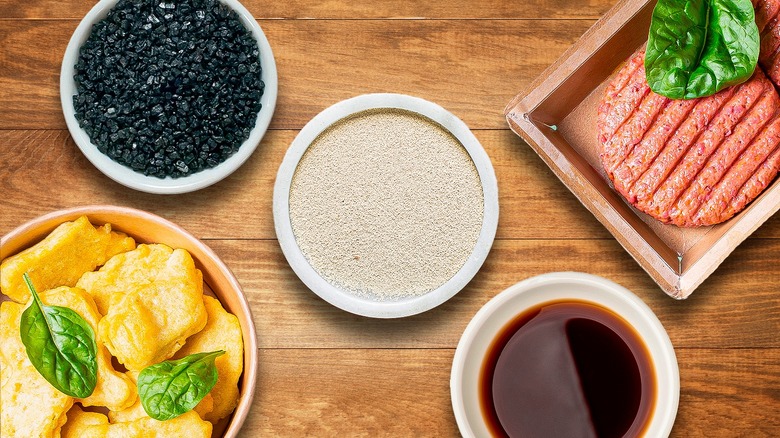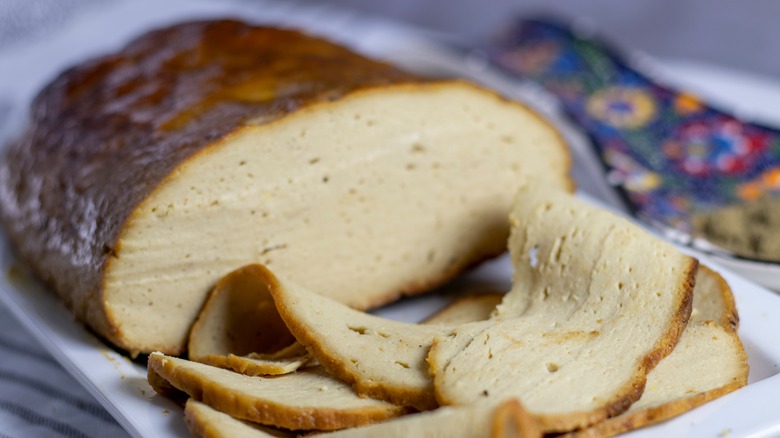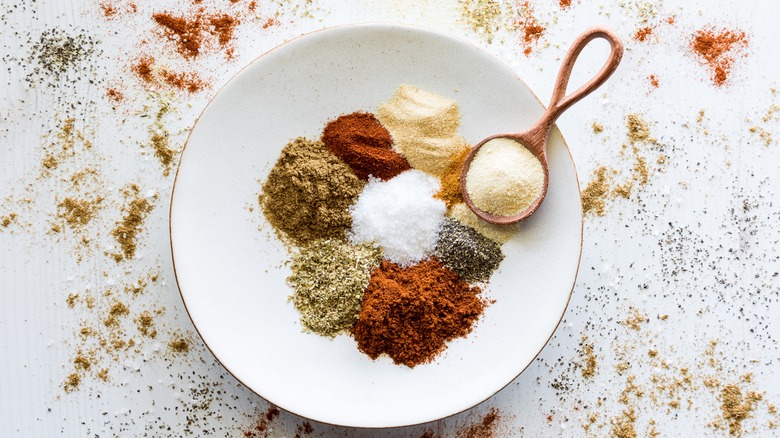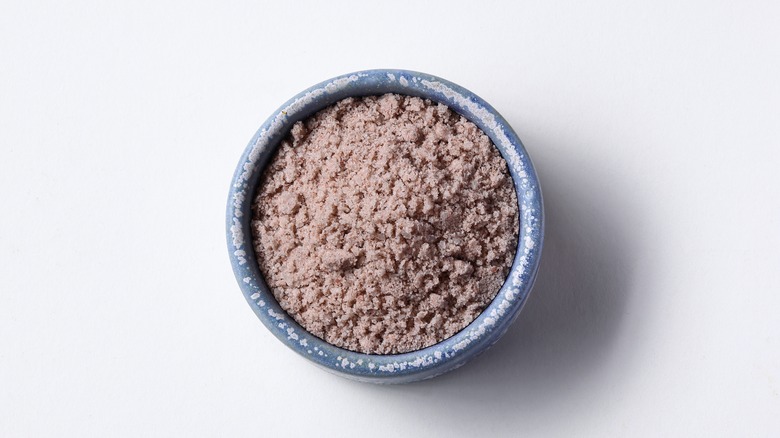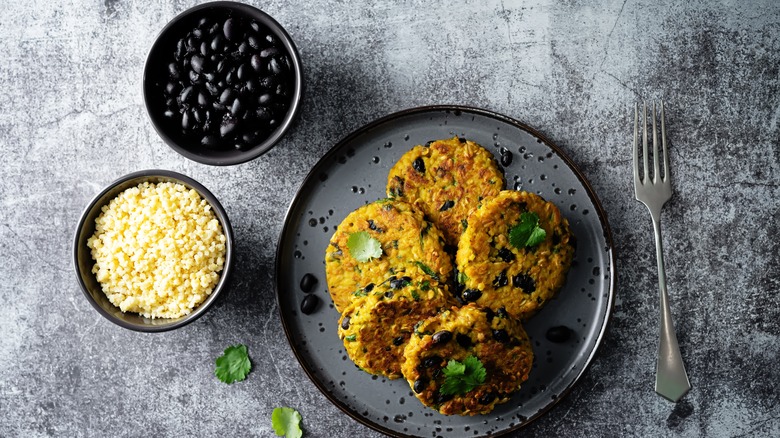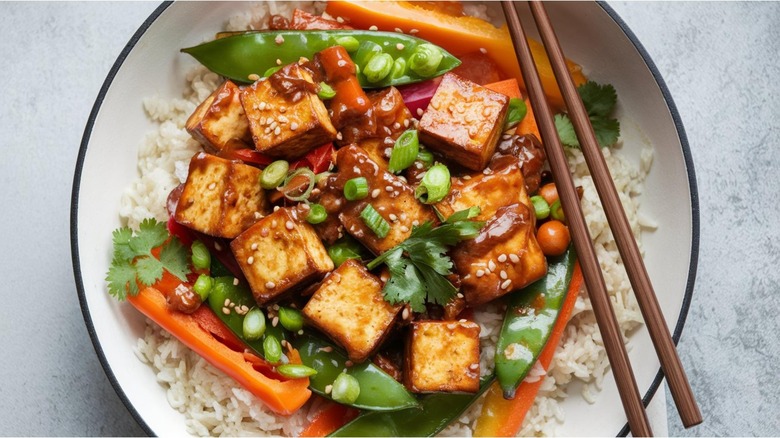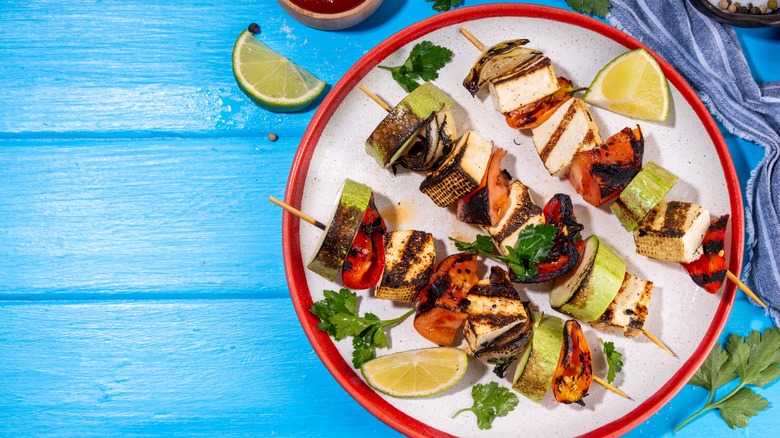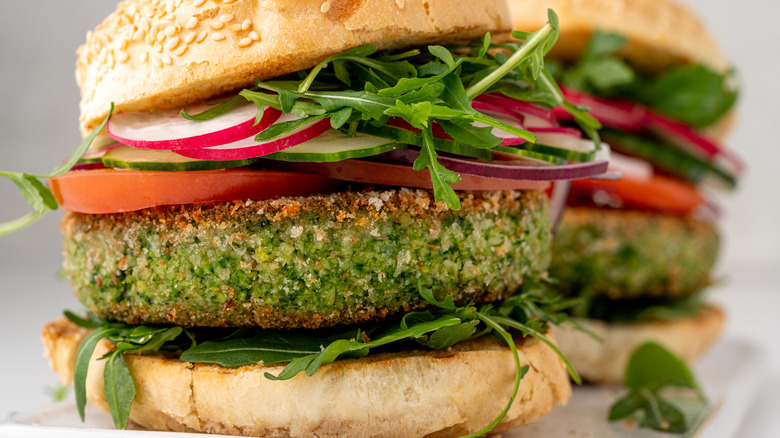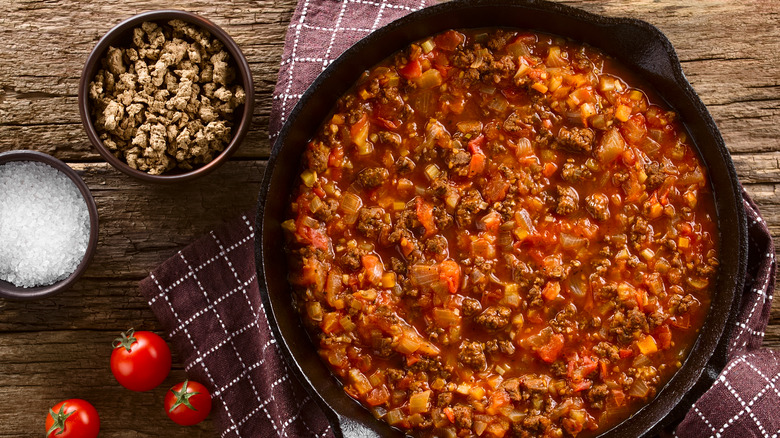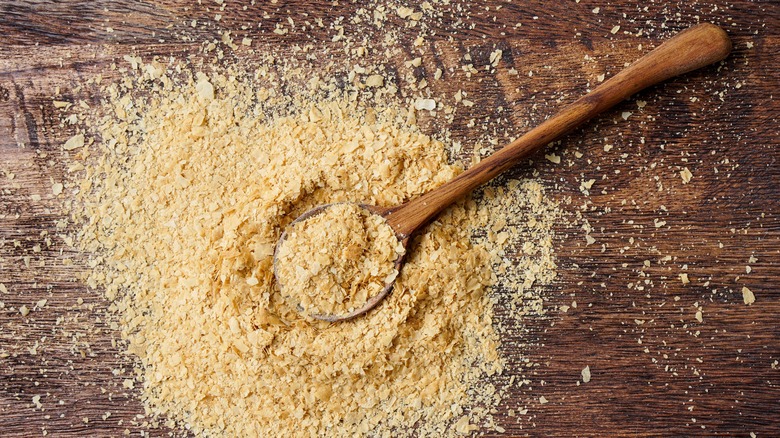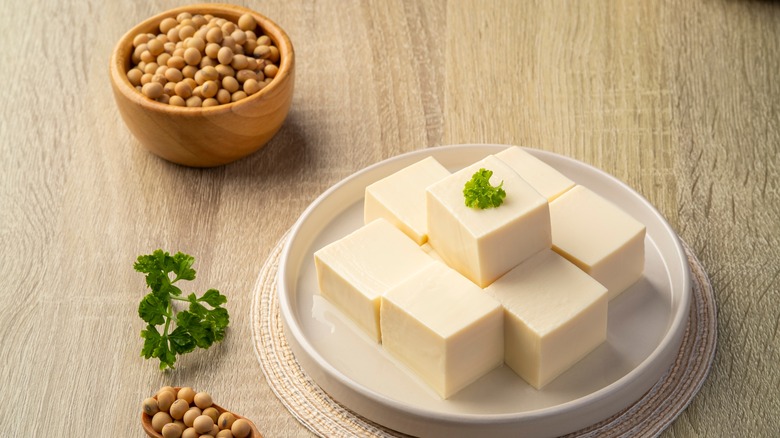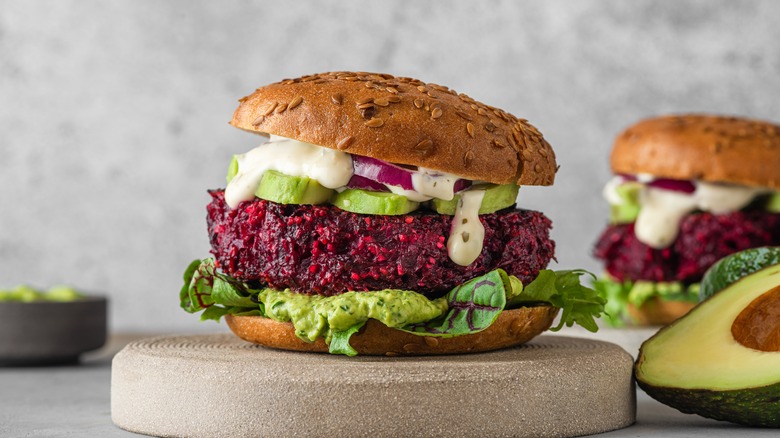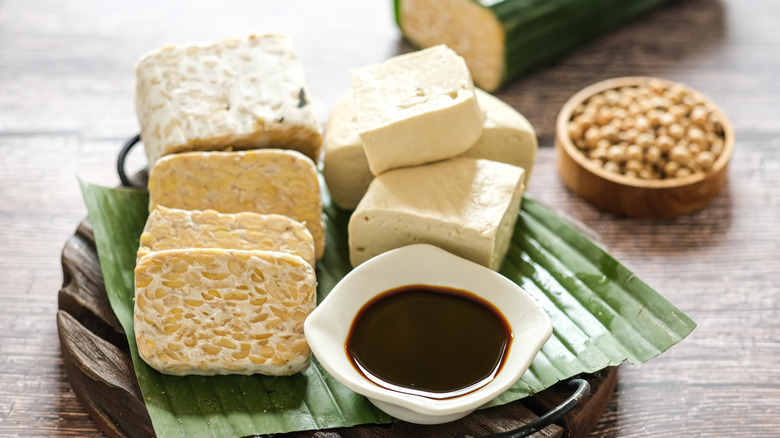13 Flavorful Ways To Improve Plant-Based Meat Substitutes
Working with a plant-based meat substitute for the first time can be a daunting task. The biggest, and one of the most common, mistakes that people make with these proteins is approaching them as they would meat. In short, a cut of firm tofu will never taste like steak, nor will a seitan have the same salty mouthfeel as a piece of pastrami. If you set the bar at this level, you'll be disappointed every time. But, that doesn't mean you have to settle for flavorless meat substitutes; you just have to approach them from a different angle than conventional, meat-based proteins.
As someone who has eaten vegan (and now vegetarian) for nearly a decade, I've experienced the good, the bad, and the tasteless when it comes to these substitutes, and learned a lot along the way. To help novice vegan cooks or folks looking to switch up their dinner routine with more plant-based options, I've created a list of some of my favorite ways to spruce up the flavor and consistency of these meat substitutes.
Go heavy with the liquid smoke in your homemade seitan
Seitan is far from the first protein that I would recommend that novice plant-based cooks try making at home. Seitan is made from vital wheat gluten or washed flour, the latter of which involves removing all the starch from conventional flour to concentrate the protein matrix. The gluten itself has a bit of an odd taste, which can be described as "tire rubber," but it can be easily subdued with the addition of other ingredients. One of my personal favorites to add to seitan, especially if I'm making a ham, sausage, or deli meat substitute, is liquid smoke.
Liquid smoke concentrates the flavor notes of the respective wood that it's smoked with. When combined with other umami-rich additions, like tomato paste, miso, or soy sauce, it gives this flavorless lump a bit of an edge. You'll just need to be careful when adding the liquid smoke, as too much can overtake the flavor and aroma of your seitan loaf.
To counteract the gluten flavor of this meat substitute, I also cut back on the vital wheat gluten (which is already an isolated protein) with pureed cannelloni or white beans. I find that this gives the seitan a bit less chew, but also helps act as an absorbent bed for the flavor additions (like the liquid smoke).
Try a meatless seasoning
One of the most common questions I get asked by non-plant-based eaters is what the best seasoning is to make plant-based meat taste like, well, meat. The fact of the matter is that there is no one single seasoning that can do all this work, nor is there one that can completely replicate the flavor. But, some brands have come really close to it.
Two of my favorite Trader Joe's seasoning blends to keep on hand are the Mushroom & Company Multi-purpose Umami Seasoning Blend and the Chickenless Seasoning. The former is a great addition to any dish where you need a little umami kick, but not a detectable mushroom flavor. I add it to homemade veggie burgers all the time and have also found it to be a delectable addition to meatless soups. The Chickenless Seasoning is a bit more utilitarian; I love adding it to a vegan version of a chicken salad (made with chickpeas or Gardein frozen Chik'n Strips). It adds a subtle saltiness that is really welcomed and eerily chicken-like.
That being said, another critical ingredient that all vegans should have on hand is vegetable broth. Anywhere in a recipe where water is listed, swap it out for vegetable broth for a slightly more robust flavor. If you don't have enough space in your pantry, you may also consider keeping a vegetable bouillon on hand; I'll occasionally add the paste to tofu and tempeh marinades to give them a salty depth.
Pull out the black salt
Black salt is, by far, one of the most interesting vegan ingredients you can keep in your pantry, and one that will change your recipes forever. It also goes by "kala namak" and has the flavor of a sulfuric egg — packed into tiny, easily usable salt crystals. When you taste it in something, it's quite distinct — and there's no ingredient quite like it.
Despite having "salt" in its name, black salt offers more umami notes than salty ones. You'll want to employ it whenever you want to add an eggy flavor to your food. For one, you can try to add it to foods that would normally contain eggs, like a tofu-based "egg salad". Or, you could use it in a batter for fried tofu to give it a more umami edge. Like all powerful seasonings, though, you'll want to refrain from adding too much to your recipe and shifting the balance towards something that both tastes and smells like a rotten egg.
Add mushrooms to your bean burgers
One of the best ways to add flavors to meat substitutes (like veggie burgers) is to assess the ingredients that the patty is made from in the first place. I've found that veggie and black bean burgers tend to lack substantive flavor because they're made with ingredients that don't have all that much flavor on their own. For example, black beans and brown rice make for a great structural addition to your patties, but they taste rather bleak.
To construct a great and flavorful veggie burger at home, you'll instead want to search out components that can offer both flavor and texture — like mushrooms. Mushrooms have that spongy, meat-like bounce to them, and they can also help keep your patties moist. Plus, the umami and earthiness of mushrooms is sublime; especially when it's hit with salty and savory seasonings like soy sauce, coconut aminos, or tamari. Granted, some mushroom varieties fare better than others in a burger. Portobellos and shiitakes are going to give you the most bang for your buck; just be sure to cook them down to release some of their moisture before adding in the rest of your burger ingredients.
Use a store-bought stir fry sauce for tofu and tempeh
There's no doubt about it: Plant-based meat substitutes come with a bit of a learning curve. But, that being said, you can always simplify the process of imbuing your plant-based substitutes with flavor by using a store-bought marinade or sauce. For example, if you're looking to get into tofu (which is admittedly quite hard for many folks, considering the fact it both feels and tastes like a wet sponge), try making a stir fry by tossing the cubes in a teriyaki or store-bought General Tso's sauce. The sauces have a solid balance of sweet, savory, and spicy already, which means all you need to do is cut and cube the protein of your choice. It's less work for much more flavor.
The key to working with pre-made sauces is to first consider how much liquid your protein has. Firm or extra-firm tofu, for example, will need to be pressed before it can be utilized. Otherwise, the water released during cooking will just leach out and cause the sauce to become too watery. Not only will this mess with the texture of your stir fry, but it will also dilute the flavors in the sauce. If you're using tempeh or frozen "steak" strips, you won't have to worry about draining out any excess water before you toss it in the sauce and with your vegetables or noodles.
Consider grilling your plant-based meats
When it comes to thinking about how to add more flavor to plant-based proteins, I'd recommend thinking outside the realm of conventional add-in ingredients and instead considering how exactly you cook each of the proteins. Since vegan meat alternatives are, in fact, not meat, you generally can't follow the same recommended cooking methods. But, one cooking method that often has a high return — for both meats and plant-based protein — is grilling.
It's easy to see how veggie burgers can be grilled for some extra char, but tofu is another plant-based substitute that deserves a trip over the fire. Start with an easy grilled tofu recipe, and be sure you get your grill hot. This will diminish the risk of the tofu sticking, and it will also ensure that you get the perfect char on the outside of your slices. A short trip to the grill can caramelize any of the sugars in your marinade or sauce and add a distinct smokiness to your protein. You can also grill and marinate tempeh; while the flames won't exactly tenderize the block, you will still get a slightly charred flavor, which goes well with marinades, liquid smoke, and more.
Use more than just salt
I won't sit here and discount the value that salt adds to food. All I'm saying is that salt isn't the only type of seasoning that you should employ to get a good flavor from your meat substitutes. You have to employ a range of spices, which will honestly depend on what type of food you're making and what cuisine you want to adhere to. For example, if I'm making a batch of Italian-inspired seitan sausages, I'll use fennel seeds, oregano, and dried parsley. But if a pad Thai with tofu is on the table, I'm going to go with peanuts, lemongrass, garlic, and ginger.
Moreover, you need to consider how much salt is already in your plant-based meats before adding anything more. This is especially true for plant-based meatless grounds and burgers, which are already pre-seasoned with salt (and if anything, have too much salt already). If you want to add flavor — but not as much salt — to your protein, consider adding ingredients like miso paste (which would be especially tasty in an aioli on top of your patty), low-sodium soy sauce, or coconut aminos.
Cook the meat substitutes in a sauce
It's understandable why folks have reservations about the flavor and texture of plant-based meat substitutes. But, when they're tossed into a sauce, like a vegan mushroom bolognese, you'll barely be able to parcel out any pieces. Plus, the decadent flavor of the sauce will easily soak through the protein and infuse it with flavor — all with very little work needed on your end.
You can easily add an extra dose of protein to pasta by adding crumbled tofu (or try to convert this into a "ricotta" layer in your vegan lasagna), tempeh, or my personal favorite, textured vegetable protein (TVP). I recommend rehydrating the TVP crumbles in a bowl with either broth or some pasta sauce diluted with broth before you add them to the sauce. Otherwise, you'll risk your TVP crumbles absorbing too much liquid, which can make your sauce too thick. This hack could also work for a vegan take on sloppy Joe's or a hearty chili bowl during the blustery winter months.
Pack on the nutritional yeast
If there's one ingredient that I can't get enough of, it's nutritional yeast. I always have a bag of Anthony's nutritional yeast flakes on hand for when I want to make vegan scrambled tofu – or when I want to give my sauce a little bit more of a savory and umami edge.
This ingredient, which can either come in powder or flake form, is often heralded as a "vegan cheese," of sorts. Although it won't give you the same mouthfeel as biting into a slice of cheddar, it will impart a subtly nutty and complex flavor to your plant-based meat substitutes. It's one of those "a little bit of this and a little bit of that" seasonings that you can sprinkle onto almost anything without consequence. I recommend adding a little bit to your homemade burger patties to help add depth to the grain, bean, or mushroom base or seasoning your seitan loaf liberally with it.
Marinate some plant-based proteins overnight
Time is your friend when it comes to imbuing your plant-based meat substitutes with flavor. An overnight marinade will give your plant-based proteins enough time to soak in a sauce or a seasoning so that you can taste it in every crevasse, rather than just on the outside.
Many different plant-based meat substitutes can use a marinade. Tofu is one of them. Our jerk-marinated grilled tofu recipe calls for the slices to sit in the sauce for at least two hours, but you can always leave it in there for longer. Meanwhile, tempeh can benefit from sitting in a sauce for a whole day because of how thick and coarse its consistency is.
However, some caveats come with marinating your proteins — especially when it comes to tofu. If you neglect to press the tofu before you cook it — especially if you opt for a stovetop cooking method — you'll risk all that moisture flooding out and your tofu coming out soggy. So, you'll need to adequately press out the extra moisture before cooking. Although it might seem like a lot of work (not to mention wasteful) to let your tofu soak in a marinade before pressing it out, it's important to note that if you made a solid marinade with a good balance of salt, acid, fat, and heat, its flavor should linger — and truly make a world of difference in terms of the flavor of your meat substitute.
Try a saltwater brine for your tofu
You don't have to just stick to grilling and cooking your tofu in a pan. You can also turn to shallow or pan-frying to give your tofu a unique texture and flavor. Plus, who doesn't like dipping a piece of crispy, fried food into tasty sauce?
For extra crispy and flavorful tofu, you'll need to brine it first. The salt solution will help pull out the excess moisture from your block, which will in turn help make it fry more consistently. Moreover, it will also allow the salt to penetrate the inside of your tofu. Besides using this method for pan-fried tofu, you can also use it for other cooking methods. It will upgrade the flavor of your block without forcing you to dig out every jar in your spice rack. I find it's especially helpful if you're planning on making a sauce for your tofu, rather than coating the block in herbs and spices.
You'll need to let your tofu sit in a hot water brine on the stove for about 15 minutes before you can move forward with your recipe. Just be sure to allocate enough time for the moisture to drain from the slices so that it doesn't get too soggy in the pan, which would ruin its delectable crunch.
Give your homemade burgers time to rest before cooking
I can remember the first time I made my own homemade veggie burgers from scratch. The concoction, a mixture of rice, quinoa, black beans, and veggies, immediately fell apart the second it hit the pan, and I had to shamelessly convert my dinner plan into a deconstructed burger bowl instead.
One of the tips that I wished I'd learned earlier when it came to plant-based burgers was to let them sit in the fridge for a while before I wanted to cook with them. This not only allows the ingredients to firm up, but it also helps the flavors to meld together — kind of like how resting a cookie dough in the fridge can be beneficial to its overall structure, flavor, and bake. You'll find that the savory and sweet notes of the burger are far more concentrated than if you just plopped the patty straight onto the grill or pan. You don't have to let the burgers sit for very long either; just enough time for your binders – like the oats and rice — to soak up the flavors and ingredients around them.
Steam your tempeh to reduce its bitterness
Tempeh is not the protein I would recommend that a non-plant-based eater start with, due to its peculiar flavor and texture. This block is made from a mixture of mold, soybeans, and grains — like millet and barley (appetizing, I know). As a result, tempeh has a funky, almost fermented flavor that comes off as slightly bitter. It's easy to see how eating a block of tempeh raw or under-seasoned can really turn someone off of the protein fast.
One of the most important tips for subduing that bitterness is to boil your tempeh before you cook with it. Toss the pieces into a pot filled with water or vegetable broth and allow the pieces to cook for about 10 minutes. The short dip in the water won't soften the tempeh, which means that it can still be used for tempeh bacon, stir fry, pasta sauce, or any dish where it needs some structural integrity. But, it will provide a better flavor balance and allow those sweet and savory notes from your marinade and other seasonings to shine through.
